In the rippling waters and lush landscapes of Tennessee, an array of serpentine inhabitants thrive, each carving its niche within the intricate tapestry of the state’s ecosystems.
Among these, the Tennessee Water Snakes stand out as emblematic denizens of aquatic realms, their presence weaving seamlessly into the mosaic of wetlands, rivers, and lakes that dot the region.
From the secretive slither of the Red-bellied Mud Snake to the agile glide of the Diamondback Water Snake, these aquatic marvels embody the diversity and resilience of Tennessee’s wildlife.
Different Types of Water Snakes in Tennessee
Cottonmouth
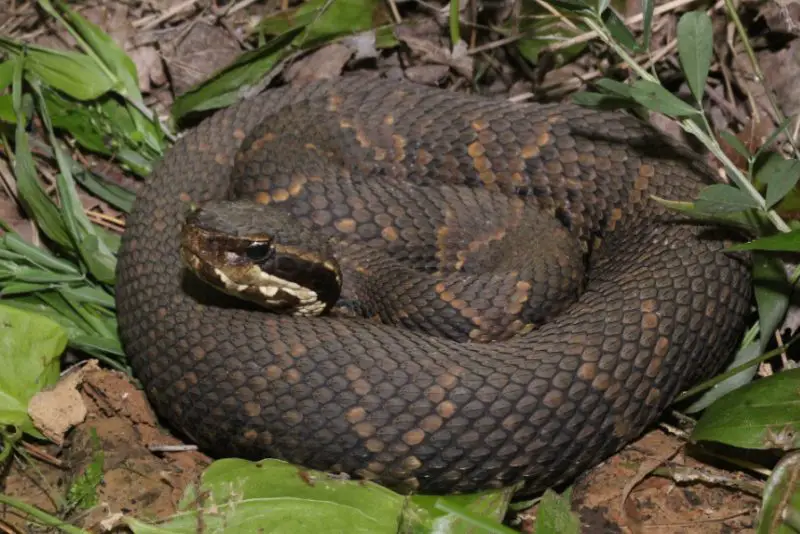
The Cottonmouth, scientifically known as Agkistrodon piscivorus, ranges in length from 30 to 42 inches and packs a venomous bite. Commonly found in the western third of Tennessee, these water snakes favor swampy habitats over lakes and rivers. Sporting a thick, dark brown body, their distinctive feature lies within their mouth, which flashes a striking white when threatened.
Despite their reputation for aggression, Cottonmouths typically opt for flight or concealment rather than confrontation. Contrary to popular belief, they seldom pursue humans and are more inclined to retreat. While caution is warranted due to their venomous nature, these snakes are not the aggressive predators they’re often portrayed as—best to let them be if encountered.
Red-bellied Mud Snake
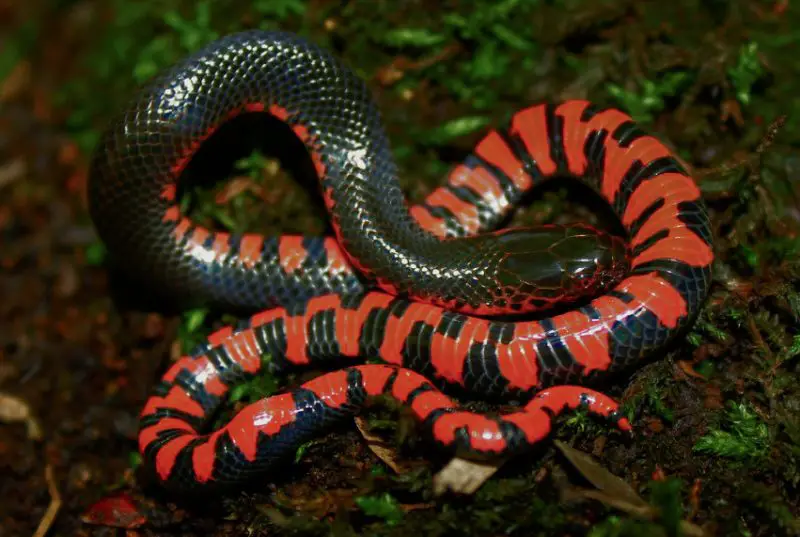
The Red-bellied Mud Snake, scientifically named Farancia abacura reinwardtii, measures between 40 to 54 inches and notably lacks venom. As a subspecies of the mud snake, it thrives in concealed habitats, favoring slow-moving or still freshwater environments. Within Tennessee, sightings are rare due to its secretive tendencies, leaving its population status relatively unknown in the state.
However, it appears most prevalent in streams and creeks surrounding Reelfoot Lake. Feeding predominantly on amphibians such as sirens and amphiumas, this species distinguishes itself with a striking red and black “zipper-like” pattern, setting it apart from other snakes inhabiting the region.
Queen Snake
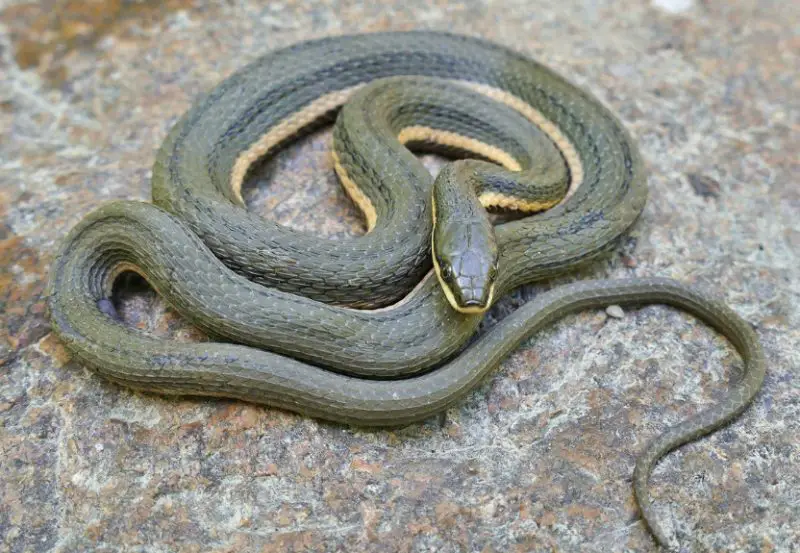
The Queen Snake, scientifically named Regina septemvittata, spans from 15 to 24 inches in length and is non-venomous. Preferring aquatic habitats, it thrives in rocky streams across central and eastern Tennessee. While their populations are currently deemed stable, potential threats loom due to dwindling prey populations and sediment accumulation.
Their diet primarily consists of crayfish, occasionally supplemented with tadpoles. Similar to numerous water snake species, they employ viviparous reproduction, giving birth to live young. Recognizable by their slender build and distinct markings, Queen Snakes navigate their watery domains with agility, contributing to the intricate ecological balance of their habitats.
Mississippi Green Water Snake
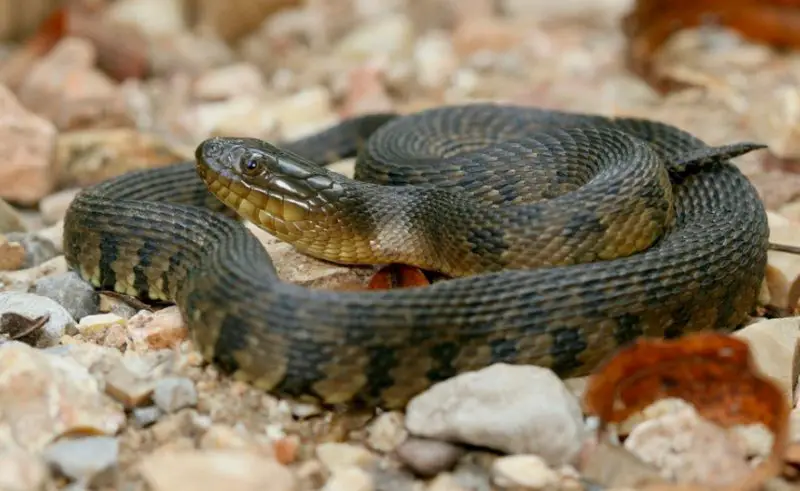
The Mississippi Green Water Snake, scientifically known as Nerodia cyclopion, measures between 30 to 45 inches and lacks venom. Thriving in the cypress swamps of the extreme western region of the state, these snakes blend seamlessly into their surroundings with their dark, greenish-brown coloring. Predominantly piscivorous, they prey upon fish, frogs, and tadpoles within their swampy habitats.
Adult individuals are characterized by distinctive half-moon-shaped yellow markings adorning their bellies. Often found basking on branches overhanging the water, they employ viviparous reproduction, giving birth to live offspring. Their preference for secluded, watery domains underscores their crucial role within the delicate ecosystems of the cypress swamps.
Plain-bellied Water Snakes
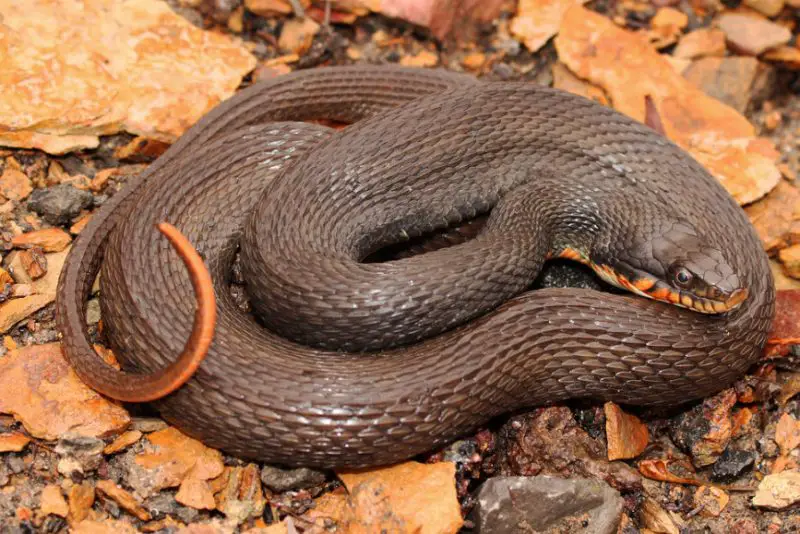
The Plain-bellied Water Snake, scientifically termed Nerodia erythrogaster, ranges from 30 to 48 inches in length and is non-venomous. Indigenous to the south-central and south-western regions of Tennessee, as well as the watersheds of the Cumberland and Tennessee rivers, these snakes exhibit a distinctive coloration. Sporting a black dorsal surface complemented by pale yellow or brown bellies, they prefer serene, slow-moving aquatic habitats, favoring lakes and swamps over rivers.
Amphibians like frogs, toads, and salamanders constitute their primary prey, although they occasionally dine on fish. Notably, when threatened, they exhibit a unique behavior—attempting to flee on land instead of seeking refuge in water—a characteristic that sets them apart from other water snake species.
Southern Water Snake
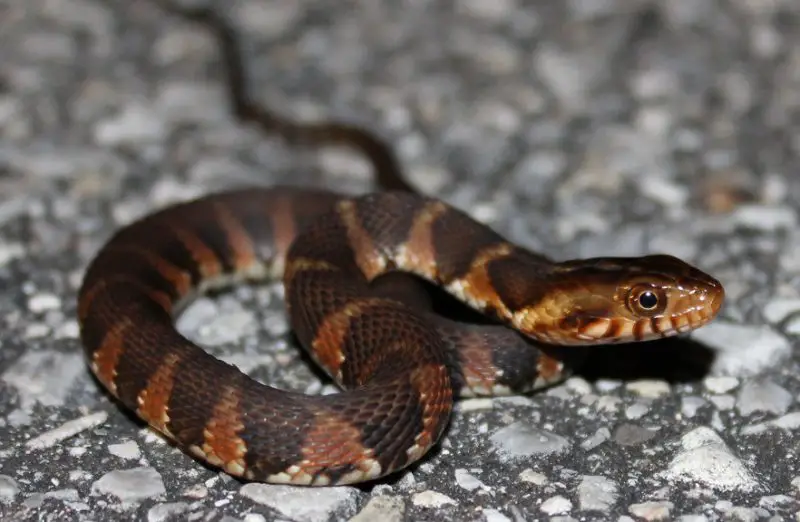
The Southern Water Snake, scientifically referred to as Nerodia fasciata fasciata, measures between 22 to 36 inches and lacks venom. As a subspecies of the banded water snake, it displays distinctive dark and light brown bands along its dorsal surface, resembling the venomous cottonmouth. In Tennessee, it inhabits areas around Reelfoot Lake and counties bordering the Tennessee River.
Preferring dense vegetation for concealment, these snakes primarily prey on fish, occasionally supplementing their diet with amphibians. Unfortunately, their resemblance to cottonmouths often leads to misidentification and subsequent harm, as they are frequently mistaken for their venomous counterparts.
Diamondback Water Snake
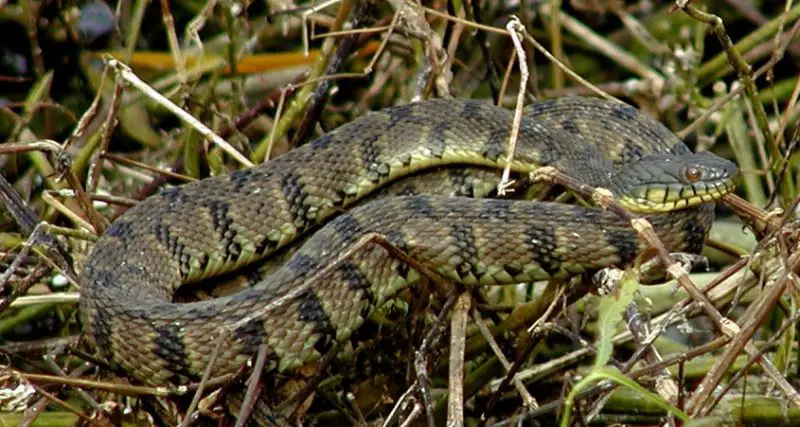
The Diamondback Water Snake, scientifically known as Nerodia rhombifer, ranges from 30 to 48 inches in length and lacks venom. Commonly sighted in western and central Tennessee, particularly within the Mississippi, Tennessee, and Cumberland river drainages, they exhibit adaptability to various aquatic habitats. However, they show a preference for oxbow lakes, rivers, and cypress swamps.
Their diet predominantly consists of slow-moving fish, with catfish being a preferred prey item. Exhibiting nocturnal behavior during the summer months, they transition to diurnal activity patterns in the winter. This species’ versatile habitat selection and feeding habits contribute to its resilience and success within Tennessee’s diverse aquatic ecosystems.
Northern Water Snake
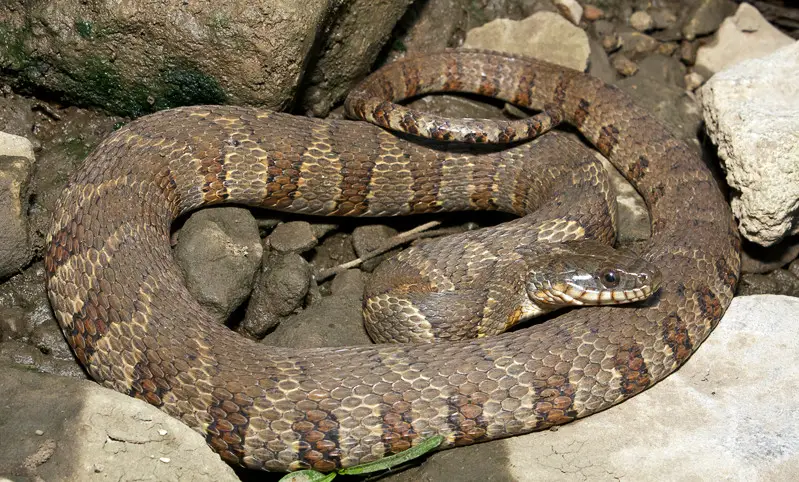
The Northern Water Snake, scientifically termed Nerodia sipedon, spans from 24 to 42 inches in length and is non-venomous. Exhibiting greater color variation compared to other species, individuals can range from gray to brown and even nearly black, with colors intensifying as they age. Widely distributed throughout Tennessee, they favor tranquil aquatic environments, particularly ponds and lakes, where they frequently bask along the water’s edge.
Primarily piscivorous, they prey on various fish species, showing a preference for non-game varieties. While amphibians are occasionally on their menu, they typically opt to flee from threats, resorting to defensive biting only when captured, underscoring their inclination towards avoidance rather than confrontation.
Western Ribbon Snake

The Western Ribbon Snake, scientifically known as Thamnophis proximus, typically measures between 20 to 30 inches and is non-venomous. Distinguished by three pale stripes tracing down their slender bodies, these snakes are closely associated with water habitats, although they spend less time submerged compared to water snakes. Confined to the four counties of far western Tennessee, they exhibit a preference for areas near water bodies.
Small frogs, tadpoles, and minnows constitute their primary diet. Renowned for their agility, they swiftly retreat into dense vegetation when threatened, employing evasion tactics rather than seeking refuge in water—an adaptation characteristic of their behavior.
Eastern Ribbon Snake
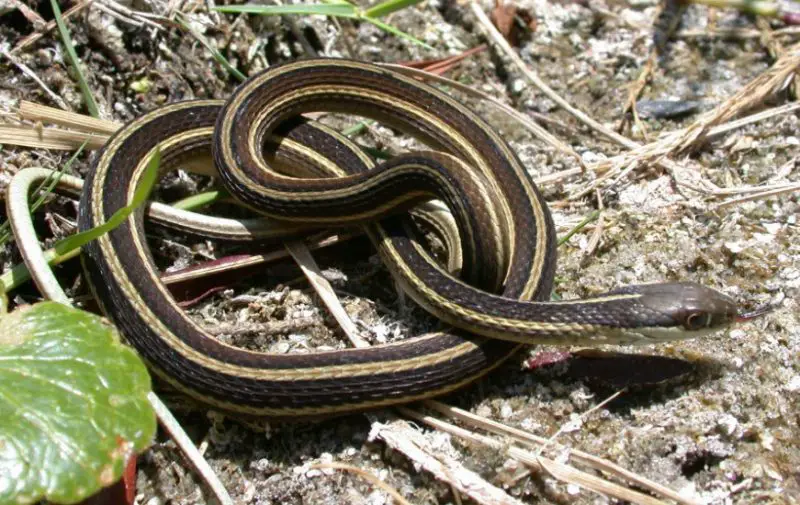
The Eastern Ribbonsnake, scientifically termed Thamnophis sauritus, ranges from 18 to 26 inches in length and is non-venomous. Predominantly inhabiting the western regions of the state, this garter snake species is characterized by three distinct yellow stripes running along its dorsal surface. While not aquatic specialists, they maintain close proximity to water bodies, favoring densely vegetated river and stream banks for both habitat and hunting grounds.
Amphibians and fish rank as their primary prey, supplemented occasionally by insects. When threatened, they exhibit a unique behavior of gliding across the water’s surface rather than submerging, utilizing water as a means of escape while remaining within their preferred terrestrial habitat.
Common Garter Snake
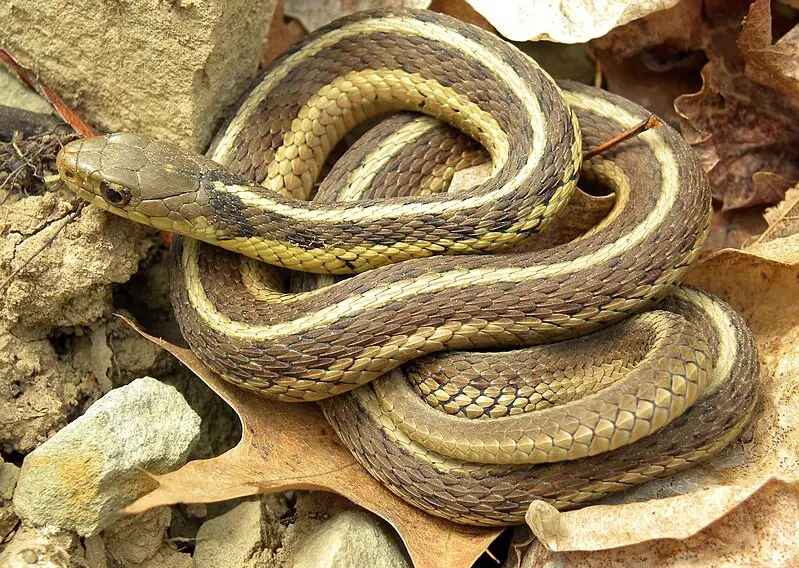
The Common Garter Snake, scientifically known as Thamnophis sirtalis, measures between 18 to 26 inches and is non-venomous. Distinguishing it from ribbon snakes, this species boasts a lighter, spotted coloration. Ubiquitous across Tennessee, they inhabit diverse environments ranging from woodlands to urban areas. Preferring proximity to ponds and wetlands, they exhibit adaptability to various habitats.
Their diet encompasses a wide range of prey, including frogs, toads, fish, and earthworms, reflecting their opportunistic feeding behavior. Renowned for their agility, they are the fastest snakes in Tennessee, evading capture with remarkable swiftness—a testament to their elusive nature and adeptness at eluding predators.






